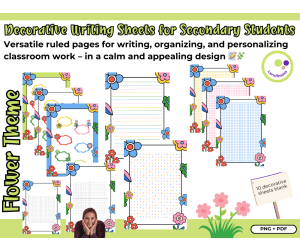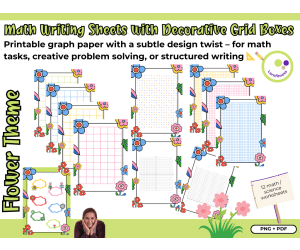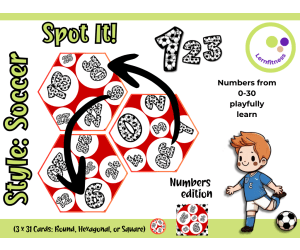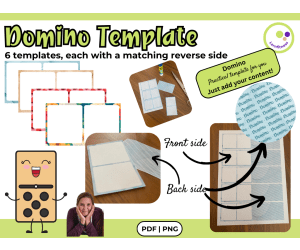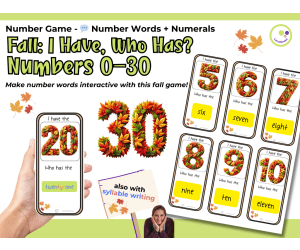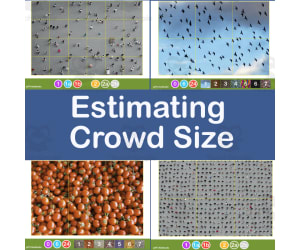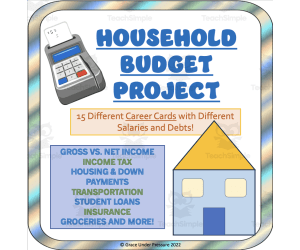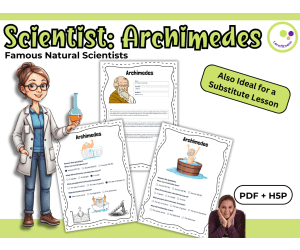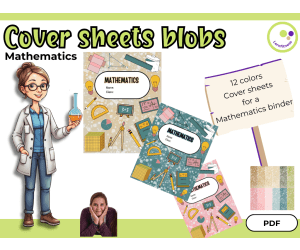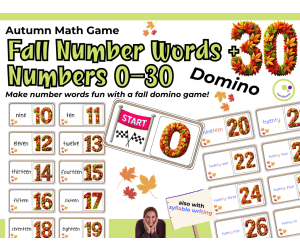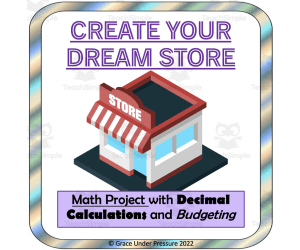2,755 products added recently
Math Projects For Middle School
Enhance your middle school math curriculum with projects that make learning dynamic and relevant. This collection includes data analysis, mathematical games creation, and applied geometry tasks. By integrating these projects into your teaching, you can deepen understanding and maintain interest in math.
Decorative Writing Sheets for Secondary Students
Science, Seasons, Holiday & Seasonal, Summer, Spring, Common Core, Handwriting, Writing, ELA, Math, Homeschool Templates, Activities, Worksheets & Printables, Worksheets, Projects, Classroom Decor, Bulletin Boards, Posters, Teacher Tools, Templates, Coloring Pages
Decorative Writing Sheets for Secondary Students Versatile ruled pages for writing, organizing, and personalizing classroom work – in a calm and appealing design 📝🌿 PNG + PDF These decorative worksheets were created with older students in mind. They combine a clean, thoughtful layout with subtle design elements that make them suitable for many classroom contexts – from creative writing to structured math problems. Each page features light, subject-neutral decorations and matching rulings. The rulings are clearly visible but not too dominant, and their colors are coordinated with the overall design. This small detail gives the pages a more polished, motivating look – without distracting from the actual task. What’s included: A selection of printable decorative writing sheets with lines All designs with age-appropriate, calm visuals Rulings in matched color tones for a cohesive appearance PDF format – great for print or digital notebooks (e.g. GoodNotes, Notability) PNG Format Ideas for classroom use: I’ve used these kinds of pages in various ways – for summaries, vocabulary practice, reflections, and even small-scale presentations. Some students appreciate having a “special” page to write on for final drafts or project titles. They’re also useful for open tasks: students might choose how to use the space, which supports creative thinking and independence. Because the sheets are not content-bound, they work well across subjects. Whether you’re teaching language arts, science, or social studies, you can adapt them to your lesson. I’ve even let students use them for personal notes or as covers for their portfolios. They also serve well during quieter phases, in tutoring settings, or as part of personalized learning folders. And for digital classrooms, students can fill them out using a stylus or keyboard. A simple, flexible resource – and a small visual upgrade that shows students their work matters. Best, Heike from Lernfitness Did You Know? I teach with a certified therapy dog, and together we create a positive and welcoming learning environment. 🐶
Author Lernfitness
Rating
Tags Blank Writing, Activity Sheets, Spring, Summer, Decorative Pages, Writing, Drawing, Custom Classroom Materials, Seasonal, Worksheets
Camping Budget Project: Gr 5-8 Budget Worksheet Personal Finance
Life Studies, Home Economics, Money, Math, Multiplication and Division, Addition and Subtraction, Grade 5, 6, 7, 8, Worksheets & Printables, Worksheets, Activities, Projects
Here’s an engaging, summer-themed, real-world math budget project for your middle grades students (in grades 5-8). The math project incorporates useful personal finance and financial literacy skills along with realistic budgeting. Each student in your class is going to plan their purchases for a summer camping trip with friends! How to Use: You will assign each student in your class a budget (I recommend between $400-$1,750). A $400 budget will be challenging, and the student might only be able to bring one friend and buy mainly low-cost items. On the other hand, a $1,750 budget will be much more luxurious, and that student will be able to more friends and choose many fancy items. Students work within their budgets, picking a low, middle, or high-cost choice for each category (tent, sleeping bag, cooler chairs, food and more). Certain items must be multiplied by the total number of campers while others (like a stove) do not. Students will add up their eleven choices and make sure they stay within their budget. They might need to make a few trade-offs and skip desired items to ensure they have the things they can't camp without. Finally, your students will calculate how much money they have left, and they will answer reflection questions shopping within a budget, earning more money, or buying things used. What's Included: 5 Page PDF It's Ready to Print and Go! - Title page/teacher instructions - 2 page budgeting worksheet: This includes all of the item choices and their prices. - 1 page reflection: This is a great way to start a class discussion about budgeting- an important life skill. - COMPLETE ANSWER KEY that includes a completed sample budget so you know exactly how to assess this project Math skills required: - adding, subtracting, and multiplying with whole numbers (up to the thousands): no decimals! This project could also be a great addition to a high school life skills classroom!
Author Grace Under Pressure
Tags Budget Project, Budget Worksheet, Camping Budget, Math Project, Financial Literacy, Personal Finance, Budget, Money Math, Life Skills, Multiplication
SUPER BUNDLE | Multiplication Activities 1-DIGIT | +180 PAGES
Math, Multiplication and Division, Multiplication, Early Learning, Elementary, Homeschool Resources, Middle School, Not Grade Specific, Games, Activities, Projects, Workbooks, Worksheets & Printables, Worksheets
SUPER BUNDLE | Multiplication Activities 1-DIGIT | +180 PAGES THIS SUPER PACK HAVE MORE THAN 180 PAGES WITH ACTIVITIES OF THE MULTIPLICATION BY 1-DIGIT. INFORMATION OF THE AUTHOR: Thank you for choosing EDITORIAL ARENAS EDUCATIVAS! Our mission is to deliver a variety of learning resources that make education enjoyable and effective for children. Don't forget to visit our store to explore products for reading, writing, math, and Spanish language skills. MAIN DESCRIPTION OF THIS RESOURCE: 1) Is the material designed in color or black and white? This document has been designed in color (if required) or is sometimes created in black and white to make your learning experience easier. 2) What age range is appropriate for this resource? Our publishing company is dedicated to creating resources for young children between the ages of 3 and 12, as well as for older students or anyone who needs them. 3) What keywords best describe this resource? We can tag this product with keywords such as: teaching resource, resources, materials, teaching materials, worksheets, educational worksheets, worksheets for children. 4) What instructions should I follow for proper printing? I recommend that you first download this document, then check if your printer is capable of printing, and also verify that you have the appropriate document size. SECONDARY AND COMPLEMENTARY INFORMATION: 1) What recommendations are there for making the most of this resource? To make the most of this resource, I recommend first analyzing it, then looking at the specific topic your student needs to learn and assess whether my resource addresses it. I also ask you to consider how you will print it. 2) Is this material up to date with the latest educational changes? Yes, this material primarily addresses all learning theories about children, which tell us that children should learn in an educational and fun way. 3) What printing format guarantees the best results? I recommend printing this document in PDF format. I would also ask you to carefully check whether you have a color or black and white printer. 4) What recognition or endorsement does the author of this material have? This document has been prepared by EDITORIAL ARENAS EDUCATIVAS, and we guarantee that this document has been carefully selected, ensuring that your students have a fun and successful learning experience.
Author EDITORIAL LAURA EDUCA
Rating
Tags FREE, FREE RESOURCES, BUNDLE, PACK, MULTIPLICATION, DIVISION, MATHS, MATH RESOURCES
Math Writing Sheets with Decorative Grid Boxes
Seasons, Holiday & Seasonal, Summer, Spring, Common Core, Math, Early Math, Graphing, Basic Operations, Geometry, Homeschool Templates, Activities, Worksheets & Printables, Worksheets, Projects, Classroom Decor, Bulletin Boards, Posters, Teacher Tools, Templates, Diagrams
Math Writing Sheets with Decorative Grid Boxes Printable graph paper with a subtle design twist – for math tasks, creative problem solving, or structured writing 📐✏️ PNG + PDF These decorative math sheets combine practical structure with visual appeal. Designed especially for math lessons, they feature a box-style ruling (also known as graph or squared paper) and gentle decorative elements that frame the workspace without distracting from the task. The colors of the rulings match the surrounding design, giving each page a calm and balanced look. Whether you’re preparing math exercises, practicing place value, or creating space for geometry sketches – these sheets provide a flexible foundation. The structured grid supports clear number alignment and helps students organize their work, especially those who benefit from visual guidance. What’s included: A variety of printable decorative worksheets with math box rulings Rulings in colors matched to the design Subtle seasonal or subject-neutral decorations PDF format – for printing or use in digital notebooks (e.g. GoodNotes, Notability) PNG Format How I use them in class: I often reach for these sheets when I want to give a task a more finished or thoughtful appearance. Students use them for solving equations, drawing coordinate grids, or organizing data. They also work well for math journaling or scaffolded tasks, where a clear layout makes thinking visible. The design encourages careful work without being overwhelming – especially useful for students who struggle with messy layouts or find blank pages intimidating. Because the visuals are gentle and age-neutral, they’re suitable from upper elementary through secondary levels. They can also serve as project covers, learning logs, or a base for differentiated tasks. Sometimes, it’s these small details – like using a well-designed worksheet – that make students take their work a little more seriously. Best, Heike from Lernfitness Did You Know? I teach with a certified therapy dog, and together we create a positive and welcoming learning environment. 🐶
Author Lernfitness
Rating
Tags Activity Sheets, Spring, Summer, Decorative Pages, Writing, Drawing, Custom Classroom Materials, Seasonal, Worksheets, Math Writing Sheets
Autumn Number Match Game – Spot the Number 0–30 Fall
Holiday & Seasonal, Language Development, ELA, Special Resources, Special Education Needs (SEN), Math, Early Math, Numbers, Seasons, Fall, Preschool, Grade 1, 2, 3, 4, 5, Activities, Games, Worksheets & Printables, Task Cards, Quizzes and Tests, Teacher Tools, Projects, Flashcards, Centers
Autumn Number Match Game Spot It Style Cards for Numbers 0–30 This autumn number game is built on the idea of the classic “Spot It” style, but instead of pictures, the focus here is on numbers. Students practice recognizing numbers from 0 up to 30 while playing against each other in a quick, visual matching activity. I first used it in my math centers in October, when the fall theme felt right, and it has been easy to bring out again each year. The resource includes 93 cards in total. There are three full decks of 31 cards each, and every two cards always share exactly one number in common. The decks come in three shapes—round, square, and hexagon—so you can choose what works best for your classroom. I usually cut one set of square cards for daily use because they are fastest to prepare, and then I keep the round set laminated for special occasions. The rules are simple. Each student gets a card. A card from the pile is placed in the middle, and everyone searches for the one number that appears on both. The first student to spot it calls it out and collects the card. The winner is the one with the most cards at the end. The pace keeps the game lively, and students naturally want to play more than once. What I like about this game is the flexibility. For beginners, I often reduce the range to numbers 0–10 so it feels manageable. Later I expand to 0–20 or the full 0–30. Some groups add their own rules, like playing in teams or keeping tally marks on a score sheet, which gives them extra practice with recording numbers. It works well as a math center, a partner game, or as an activity for early finishers. Because it takes only a few minutes to explain, I sometimes use it at the end of class when we have a little extra time. The autumn design makes it seasonal, but the math practice—recognizing and saying numbers—fits into any unit on counting and number sense. Preparation is easy: print the cards, cut them out, and laminate if you want them to last longer. I store mine in small envelopes so they are ready whenever I need them. Warm regards, Lernfitness Did You Know? I teach with a certified therapy dog, and together we focus on creating a positive and inspiring learning environment.
Author Lernfitness
Rating
Tags ESL, Game, Educational Card Games, Elementary, Spot It, Math Game, Numbers, Counting, Matching Cards, Fall
Math Counting Game – Soccer Style | Learning for Elementary & ESL
Montessori, Math, Numbers, Early Math, Holiday & Seasonal, Addition and Subtraction, Addition, Subtraction, Basic Operations, Counting, Preschool, Grade 1, 2, 3, 4, 6, Activities, Games, Worksheets & Printables, Task Cards, Quizzes and Tests, Teacher Tools, Quizzes, Projects, Flashcards
Math Counting Game – Soccer Style | Learning for Elementary & ESL Similar to Dobble / Spot it! A fast-paced matching game for practicing numbers and visual attention ⚽🔢 This printable math game brings energy and movement into your classroom while helping students build number recognition and quick comparison skills. Based on the well-known "Spot it!" or "Dobble"-style format, this version adds a fun soccer theme that makes counting and comparing numbers more engaging – especially for younger learners. The game works by matching identical images between cards – and there’s always exactly one match per pair. Students need to stay focused, scan quickly, and name what they see. While it feels like a game, they’re actually reinforcing visual perception, number familiarity, and quick decision-making. What’s included: 93 cards in total Three full versions of the game, each with 31 cards Shapes: round, square (easy to cut), and hexagonal formats PDF for printing and optional laminating How I use it in class: This game fits well as a math center, for partner or small group work, or even during indoor break times. I’ve also used it as a warm-up or transition activity – it gets students thinking and interacting right away. You can adjust the pace depending on your group: competitive rounds for fast learners, or slower matching for quieter moments. Students love the soccer theme, and because the same core set is provided in three different formats, I can choose what’s easiest to prep depending on the time I have. The game supports social interaction, cooperation, and focus – and since students often already know how this kind of game works, the learning curve is minimal. Just print, cut, and you’re ready to go. Warm regards, Lernfitness Did You Know? I teach with a certified therapy dog, and together we focus on creating a positive and inspiring learning environment.
Author Lernfitness
Rating
Tags Numbers, Math, EFL, ESL, Foreign Languages, Game, Spot It, Educational Card Games, Number Words, Soccer
Blank Domino Templates – With Matching Backs for Easy Printing
STEM, Science, Montessori, Common Core, Creative Arts, Graphic Arts, Resources for Teachers, Classroom Management, Math, Holiday & Seasonal, Grade 6, 7, 8, Activities, Games, Worksheets & Printables, Task Cards, Quizzes and Tests, Teacher Tools, Flashcards, Escape Room, Projects, Templates
Blank Domino Templates – With Matching Backs for Easy Printing A creative resource for designing your own domino games – in class or at home These printable domino templates offer a simple and flexible way to create your own domino-style learning games. Whether you’re planning a classroom activity, a subject-specific matching task, or even a commercial resource, this set makes the design process much easier. The download includes 6 ready-to-use templates, each laid out on a single A4 page in PDF format. Each domino comes with a color-matching reverse side labeled “Domino” – so once printed, you can fold and glue the sheet to create double-sided domino cards that feel polished and consistent. What’s included: 6 different blank domino layouts (PDF) Coordinated reverse sides for each template PNG versions of fronts and backs for flexible digital design Instructions for use (folding, gluing, optional laminating) Ideas for classroom use: I've used these templates in lessons where students create their own review materials. For example, after a unit on chemical elements or vocabulary sets, students design their own dominoes in pairs – matching concepts, definitions, or images. It’s a nice way to check understanding and encourage collaboration. Because the structure is already in place, the focus stays on content, not formatting. For digital or printable projects: You can insert your own content in programs like PowerPoint, Keynote, or Canva. Just add images or text boxes to the template and print. If you plan to laminate them, they’ll hold up well for repeated use. Commercial use is allowed under specific terms: the templates must be used as part of your own content, not shared in their original form. Attribution is requested (details provided in the download). A flexible tool for anyone who enjoys designing learning games – or wants to hand over the creative part to students! 📍 Best wishes, Heike from @Lernfitness Did You Know? I teach with a certified therapy dog, and together we create a positive and welcoming learning environment. 🐶
Author Lernfitness
Rating
Tags Educational Card Games, STEM Science Matching Game, Game, Domino, Differentiation, Template, Blank Domino Templates, Editable Domino Game, DIY Classroom Game, Matching Game
Fall I Have, Who Has? Game – Numbers and Number Words 0–30
Holiday & Seasonal, Language Development, ELA, Special Resources, Special Education Needs (SEN), Math, Early Math, Numbers, Seasons, Fall, Preschool, Grade 1, 2, 3, 4, 5, Activities, Games, Worksheets & Printables, Quizzes and Tests, Teacher Tools, Quizzes, Projects, Centers, Read Alouds
Fall I Have, Who Has? Game – Numbers and Number Words 0–30 This autumn version of “I Have, Who Has?” gives students practice with numbers and number words from 0 up to 30 . I like to use it in October, when the seasonal design adds a bit of variety to our math centers. The familiar format makes it easy for students to understand, and the game naturally gets everyone involved. The set includes two complete versions. One uses standard number words, while the other shows the words broken into syllables for students who need extra support with reading. That option has been especially helpful for children who find longer number words like “seventeen” or “twenty-three” difficult to read in one piece. You can decide how many cards to use depending on the group. For beginners, I usually stop at 0–10. As students gain confidence, I extend to 20 and then to 30. This makes the same resource usable across different levels without much extra planning. Playing is straightforward. The student with the start card begins by saying, “I have zero. Who has one?” The next student responds and the chain continues until the last card is read. Because students must listen carefully and wait for their turn, the game encourages attention, listening skills, and turn-taking alongside number practice. I have used this game in whole-class lessons, where everyone sits in a circle and plays together, and in small groups for targeted practice. It also works well for early finishers since once they know the rules, they can play independently. Preparation is simple. Print the cards, cut them apart, and laminate if you plan to reuse them. I store each set in a small envelope labeled with the range (10, 20, 30), so it’s easy to grab the version I need. This activity combines math and literacy practice with teamwork in a way that feels light and seasonal, but the skills—number recognition, word reading, and listening—are useful at any time of year. Warm regards, Lernfitness Did You Know? I teach with a certified therapy dog, and together we focus on creating a positive and inspiring learning environment.
Author Lernfitness
Rating
Tags Game, Educational Card Games, Elementary, Math Game, Numbers, Counting, Matching Cards, Who Has It?, Fall, Autumn
Estimating Crowd Sizes using Jacob's Method
Math, Statistics, Grade 7, Activities, Projects
This investigation focuses on estimating the size crowds or even large collections of objects using some very basic mathematics. Jacob's Method of counting large crowds involves creating a grid that divides a given area into equal size squares. An estimate is made by counting the number of people in a few squares, then multiply the average obtained by the number of squares in the grid. What would happen if you use different size grids ? How do the estimates compare between pupils ? Could you get a more accurate estimate if you took all the estimates in the class and calculated th average? These and many more questions are presented on the worksheet provided along with a number of pictures of multiple objects and crowds with & without prepared grids for printing or viewing on a computer screen. This activity encourages sharing and comparing of data, refining methods of collection of the data and discussion about the accuracy and limitations of the method used. The package includes: Teachers Guidance Notes An introduction into Jacob's Method and a guide to the Worksheets Estimation Worksheet A Worksheet for the students on how to use Jacob's Method and record the data. A list of questions for discussion. Estimation Crowds To be used as a starter with the student's Estimation Worksheet containing 2 crowds of different densities. Pupils begin by guessing the size of each crowd, then estimate with a 6 square grid & 24 square grid using Jacob's Method. Estimation Samples 1 and 2 14 pictures to choose from all of which have a fairly even distribution: crowds of people, tomatoes,stars, trees, bricks, flowers, balloons, birds and more. Pupils estimate with no grid, a 6 square grid & 24 square grid, and are encouraged to experiment further with other grid sizes of their own. Estimation Sample 3 7 more pictures to choose from, but this time the distribution of the populations are not so even or regular, so its more challenging and opens up more questions. They include a football crowd, bubbles, two other crowds, a shoal of fish and a herd of wildebeast. There is lots to practice with & an excellent topic for critical thinking without the need for advanced math and can be extended into investigating bias in crowd counting. Note: All the documents are printable. To view the sample populations with the grids on a computer you will need the Adobe Acrobat Reader on a PC or Mac. Common Core Links at 7th Grade CCSS7.SP.A.1 Understand that statistics can be used to gain information about a population by examining a sample of the population; generalizations about a population from a sample are valid only if the sample is representative of that population. Understand that random sampling tends to produce representative samples and support valid inferences. CCSS7.SP.A.2 Use data from a random sample to draw inferences about a population with an unknown characteristic of interest. Generate multiple samples (or simulated samples) of the same size to gauge the variation in estimates or predictions. For example, estimate the mean word length in a book by randomly sampling words from the book; predict the winner of a school election based on randomly sampled survey data. Gauge how far off the estimate or prediction might be.
Author Jeff's Notebooks
Tags Math, Statistic, Data Collection, Estimating, Estimating Crowds, Jacob's Method, Estimating Population Size, Math Investigation, Jeff's Notebooks, Data Handling, Estimating Crowd Size, Crowd Size Estimation
Financial Literacy: Household Budget Project
Life Studies, Math, Decimals, Money, Finance, Home Economics, Grade 8, 9, 10, 11, 12, Activities, Projects
Financial Literacy: Household Budget Project - Taxes, Insurance, Loans, Rent, Groceries and More! This resource is a ready-to-print and engaging project designed to teach high school students about personal finance and budgeting.. Each student is assigned a fictional career with a specific salary and student loan debt- which makes the budgeting process as realistic as possible! You could be a doctor with a high salary and a huge debt, a cashier with no debt but a very low salary, or something in between. Tasks: Income tax calculations using percentages written as decimals Rent options research and saving up for a house down payment in the future Loan repayment (if you have one) Transportation options: bus, leasing a car with no money down, saving up for a car Budget allocations for food and clothing Making monthly payments such as health insurance, electricity bills, and subscription services The flexibility of this project allows students to work at their own pace following the step-by-step instructions. If they encounter a shortfall in funds, they will need to re-evaluate their spending habits which offers an invaluable lesson in financial prioritization. Sometimes you can't have it all! Grades to Use With: This lesson is primarily designed for high school students in grades 8-12. It could be used in math class, career and personal planning, or family studies course. It could also be used for enrichment in grade 7 or in a life skills class with enough support and the use of calculators. Flexible Application This project can be used for whole-group instruction, small-group work, or an independent project. All of the instructions are clearly included, so students should be able to work at their own pace. At the end, a reflection is included so students can discuss what they have learned about the budgeting process. This is the kind of learning that stays with students long after math class ends! What's Included: A total of 7 pages in PDF format including 15 unique career cards to assign to students. If you like this personal finance lesson, check out others in my store: Taxes, Tips, Sales Inflation Renting vs Buying a Home Income Tax
Author Grace Under Pressure
Tags Financial Planning, Budgeting, Personal Finance, Math Skills, Taxes, Loans, Rent, Groceries, Financial Literacy, Real World Math
Archimedes – Scientist Profile and Comprehension Activities PDF + H5P
Life Sciences, Science, STEM, Social Studies, Biographies, Inventors, Basic Science, Physics, Chemistry, Math, Grade 6, 7, 8, 9, Worksheets, Worksheets & Printables, Quizzes, Quizzes and Tests, Teacher Tools, Projects, Activities
Archimedes – Scientist Profile and Comprehension Activities Informational Text, Student Tasks & Quiz (PDF, DOCX, H5P) ⚖️🧠 This resource introduces students in grades 7–10 to Archimedes, one of the most influential figures in early science. Best known for his work on buoyancy and the principle of density determination for irregular objects, Archimedes connects classical thought with key scientific concepts still taught today. The material combines factual reading with structured tasks. It can be used flexibly: in science lessons, for cross-curricular units, or as an easy-to-run activity in substitute teaching. Students read a short informational text, fill in a profile worksheet, complete quiz questions, and – if time allows – create their own questions to exchange with a partner. What’s included: Informational text about Archimedes Profile worksheet for comprehension and reflection Answer key for the profile Quiz questions with solutions Two extension tasks: – Create your own questions – Exchange and answer a partner’s questions File formats: – Printable PDF – Editable DOCX (text only) – Interactive H5P version (text-based, no images) In the classroom: I’ve used this kind of resource in regular science lessons as well as in non-specialist cover lessons. The tasks are clear enough for independent work and provide a good balance between reading, writing, and critical thinking. The H5P version allows for easy digital use on learning platforms, especially when students work from home or on devices in class. It’s also great for differentiation: stronger students can work on their own questions, while others use the glossary or reread sections to complete the basics. Whether you use it to introduce Archimedes in physics or to practice nonfiction reading strategies, this is a flexible resource that’s ready to go with little prep. Have fun exploring the world of science with your students! Warmly, Lernfitness Did You Know? I teach with a certified therapy dog, and together we focus on creating a positive and inspiring learning environment.
Author Lernfitness
Rating
Tags Science, Famous Scientists Lesson, H5P, Interactive Science Exercises, STEM, History, Scientists, Chemistry, Archimedes, Scientific Concepts
Mathematics Binder Covers – Templates for Classroom Use
Science, STEM, Basic Science, Special Resources, Montessori, Classroom Management, Resources for Teachers, Math, Physics, Technology, Homeschool Templates, Grade 6, 7, 8, 9, Worksheets, Worksheets & Printables, Teacher Tools, Projects, Activities, Workbooks, Drawing Templates & Outlines, Templates, Graphic Organizers, Classroom Decor
Mathematics Binder Covers – Templates for Classroom Use Organize your Math handouts, notes, and units with visual clarity Simple and flexible templates to help organize your Mathematics materials In my math classes, it can be a challenge to keep things organized - especially when it comes to multiple units, lab notes, worksheets and review materials. To make it easier for my students and myself, I designed these simple binder sleeves. There are 12 different pages. The covers have a clean, colorful blob layout that is friendly but not distracting. I usually print them out and use them as cover sheets or as dividers in folders for students or teachers. They also work well for digital learning environments, e.g. as section covers in PDF files or on classroom platforms. I like that the color scheme allows students to quickly find what they are looking for, and it brings a little more structure to a subject that is often riddled with formulas and technical terms. When used as cover sheets, students can choose their favorite color for their cover sheet. This resource is handy - and has saved me a lot of time in lesson preparation and follow-up. What’s included: 12 math-themed cover pages different colors zu choose as a cover sheet as a divider between the individual Mathematics topics I've printed these on colored paper for my own binder and also used them digitally in student notebooks. Works well for both teacher organization and student-facing materials. 📍 Best wishes, Heike from Lernfitness Math teacher (Chemistry teacher, Biology teacher) in Germany Did You Know? I teach with a certified therapy dog, and together we create a positive and inspiring learning environment. 🐶✨
Author Lernfitness
Rating
Tags Science, STEM, Binder, Cover Sheet, Template, Organizer, Organize, GoodNotes, Mathematics, Math
Personal Finance and Budgeting Project
Life Studies, Finance, Home Economics, Math, Money, Grade 6, 7, 8, 9, 10, 11, 12, Activities, Teacher Tools, Lesson Plans, Projects
Personal Finance and Budgeting Project Understanding personal finance and budgeting is essential, especially as students transition into adulthood. This Personal Finance and Budgeting Project is developed to equip middle and high school students with the foundational knowledge they need in financial literacy and consumer math. Personal finance isn't just about numbers. It's about making informed decisions that shape one's future. That's why this project doesn't merely provide facts; it immerses students in real-world scenarios. By navigating these activities, students will grasp the significance of budgeting, realize the potential pitfalls of poor money management, and appreciate the power of informed financial choices. Why is this resource valuable? The truth is, many grown-ups wish they had learned about budgeting sooner. By introducing these concepts early on, educators can give their students a head start, ensuring they have the tools they need to make wise financial decisions throughout their lives. The activities are versatile, allowing for flexibility in teaching. Whether educators prefer to stretch them out into individual lessons or consolidate them into a more extensive project, the choice is theirs. Plus, given the editable nature of this resource, teachers have the liberty to adjust content to better fit their students' needs and the specific objectives of their lesson plans. Some of these activities include: Glossary Interview Activity Needs vs Wants Activity Needs vs Wants Reflection Questions Financial Circumstances Comparison Questions Budget Basics Video Penny Wise Budget Game …. and more!! Whether carried out in the classroom or at home, this resource offers a practical and engaging approach to a topic that, frankly, is often overlooked. As educators, we strive to prepare our students for all facets of the real world. This includes not only academic knowledge but life skills as well. By delving into the realm of personal finance and budgeting, we're setting them up for a lifetime of informed, empowered decisions.
Author Mister G's Teacher Shop
Tags Personal Finance, Consumer Math, Financial Literacy, Budget, Monthly Budget, Finance, Project, Google Slides, Small Group, Real World
Human Body and Golden Ratio PowerPoint and Study Guide
Math, Grade 4, 5, 6, 7, 8, Projects, Activities, Presentations, Teacher Tools, Quizzes and Tests, Rubrics, Workbooks, Worksheets & Printables
Introduction to the Golden Ratio and the Human Body PowerPoint and Study Guide Lesson The Golden Ratio, or Phi, and the Human Body is a unique math PowerPoint exploration of the human body and Leonardo da Vinci's famous Vitruvian Man drawing. Academic connections are made with math, art and history. Another famous name for the Golden Ratio is the divine proportion, a proportion of beauty found throughout nature, science, art, and architecture. This lesson can be completed in one or two classes depending on how long teachers want to spend on projects. Learners will become enthralled by the idea of how math can be beautiful and learn to treat it like a treasure hunt by looking for the golden ration everywhere around them in art, nature and even their own bodies! Go down as many learning rabbit holes with NatureGlo's MathArt Library Golden Ratio and Human Body page. On this page you'll get videos, project ideas and curated website links. Enjoy the exploration! Student Objectives Students will: Complete the PowerPoint lesson Complete the study guide for the lesson. Watch the curated educational videos from the MathArt Virtual Library Website. Complete the journal in the study guide including a drawing with written descriptions. Complete the quiz. Choose and do a chosen project. Order, Outline and Steps Read the Quick Start guide that comes with the curriculum. Go through the PowerPoint lesson with the students. Students complete the study guide during or after the PowerPoint lesson. Students select and complete a chosen projects about the topic. Grades & Ages Grades 4 - 8 Ages 10 - 14 Implementation Format PowerPoint Study guide Use of Internet Activities Projects Answer Key - INCLUDED Number of Pages - 33 File Types - PowerPoint and PDF files Length of Lesson - At least one lesson, or, optionally two or more lessons
Author NatureGlo's eScience
Rating
Tags Golden Ratio, Human Body, Divine Proportion, Math Activities, Math Projects, Leonardo Da Vinci
Fall Domino Game – Numbers and Number Words 0–30
Holiday & Seasonal, Language Development, ELA, Special Resources, Special Education Needs (SEN), Math, Early Math, Numbers, Seasons, Fall, Preschool, Grade 1, 2, 3, 4, 5, Activities, Games, Worksheets & Printables, Quizzes and Tests, Teacher Tools, Quizzes, Projects, Flashcards, Centers
Fall Domino Game Numbers 0–30 and Number Words This autumn domino game is a hands-on way for students to practice both numbers and number words from 0 to 30. I introduced it during the fall term with my grade 1 class, and the students immediately understood the rules because it follows the familiar domino format. The seasonal design added a nice touch, but the main benefit was the repeated practice with connecting numbers and words. The set includes 68 cards in total, with two different versions. One version shows the standard number words, while the second version breaks the words into syllables. I noticed that the syllable version was especially helpful for younger readers or for students who still found longer number words challenging. Words such as “seventeen” or “twenty-four” became easier to read and pronounce when broken down into smaller parts. The game can be adjusted by number range, which makes it easy to differentiate. With beginners, I often start with 0–10 so that the game feels manageable. Later I expand the set to 0–20, and eventually the full 0–30 for more advanced groups. Because of this flexibility, the same set can be reused throughout the year with different levels of learners. There are several ways to play. In small groups, students take turns matching numbers with the correct number words, trying to be the first to play all their cards. In a whole-class setting, I sometimes spread the cards across the floor and let students work together to build one long domino chain. This version turns the game into a collaborative activity and gets everyone moving while still practicing number recognition. Preparation is simple. Print the cards, cut them apart, and laminate them if you want to reuse the set in future years. I keep mine in small envelopes labeled with 0–10, 0–20, and 0–30 so I can quickly pull the right range for each group. The activity works well in math centers, small group rotations, or even as a fun review during October. Warm regards, Lernfitness Did You Know? I teach with a certified therapy dog, and together we focus on creating a positive and inspiring learning environment.
Author Lernfitness
Rating
Tags ESL, Game, Educational Card Games, Elementary, Math Game, Numbers, Counting, Matching Cards, Domino, Fall
Credit Card Project
Life Studies, Finance, Home Economics, Math, Money, Grade 6, 7, 8, 9, 10, 11, 12, Activities, Teacher Tools, Lesson Plans, Projects
Diving into the world of consumer math and understanding how credit cards work can be quite a challenge, especially for younger students who might not have any firsthand experience. This teaching resource simplifies the complexity surrounding credit cards, giving students an informed perspective on their usage, advantages, and potential pitfalls: Credit Card Project Geared towards middle and high school students, this Credit Card Project resource offers a straightforward view of several key aspects: The mechanics of how credit cards operate. Insight into how credit card companies generate revenue. The processes of making payments and understanding the billing cycle . Tips and guidance on using credit cards responsibly. To make the learning process engaging, this package is designed as a project containing a series of worksheets. These worksheets are complemented by informative videos about credit cards, and a sample credit card statement to help students visualize real-world applications. Additionally, to assist educators in assessing the students' understanding and engagement with the project, a rubric is provided. Whether you wish to integrate this resource into your classroom activities or assign it as a home-based project, its flexible structure allows for both. It serves as an invaluable introduction to credit cards, equipping students with knowledge that is crucial as they step into adulthood. For educators who want to ensure that the content aligns with their teaching methods or specific classroom requirements, the entire project is editable. This customization feature ensures that the material remains relevant and adaptable to diverse student needs and academic levels. If you're an educator aiming to impart practical knowledge about credit cards to your students in a concise and clear manner, this resource will certainly serve as a robust tool in achieving that objective. By the end of the project, students will not only have a foundational understanding of credit cards but also be better prepared for the financial choices they'll make in the real world.
Author Mister G's Teacher Shop
Tags Credit Cards, Consumer Math, Finances, Financial Literacy, Project, Small Group, Quiz, Reflection, Google Slides
Financial Literacy: My Party Budget- Decimals and Percentages Application
Life Studies, Finance, Home Economics, Math, Percentages, Decimals, Grade 5, 6, 7, 8, Worksheets & Printables, Word Problems, Activities, Projects
Financial Literacy: My Party Budget- Decimals and Percentages Application Unlock mathematics’ real-world influence with this practical math project for students in grades 5-8. This tool allows students to sharpen their intermediate math skills, particularly applying percentage calculations and decimal operations to manage a budget consciously - a vital lesson in financial literacy. This versatile resource is ideal for grades 5 to 8 classrooms as well as high school special education environments where budgeting practice complements life skills training. How to Use: Give each student a party budget. You can choose to give everyone the same budget, OR this is a great way to differentiate. Give students with emerging understanding a budget of $100 (which is easy to work with) and give students who need a challenge a budget such as $240, which will result in more complex calculations. This will also stimulate discussions about budgeting in general and the challenge of planning with less money. Students need to partition their hypothetical party budget across varied cost categories like food, decorations and entertainment by employing basic percent in decimal form and understanding addition and multiplication of decimals. For example, they might decide to spend 50% of their budget on food because that is their favourite part of a party. They will calculate 50% of their total budget. This skill application brings relevance to numbers through experiential learning. You can decide if students should complete calculations by hand or if using a calculator is allowed. Also, a complete sample answer key is included that you can show to your students to demonstrate the task. Finally, students complete shopping research and choose items online or in store flyers. This fosters strategic thinking when managing limited resources. You can have a discussion about making tradeoffs (for example, choosing frozen pizza instead of fresh to have extra money for a party activity OR inviting fewer guests to have more money for party favours per person). What's Included: A total of 8 pages in PDF Format Title Page Teacher Instructions 3 Page Student Worksheets 3 Page Sample Answer Key
Author Grace Under Pressure
Tags Financial Literacy, Decimals, Percentages, Budgeting, Math Application, Budget, Real World Math, Math Project, Applied Math, Party Project
Math Project: Create your Dream Store: Decimal Calculations and Budgeting
Life Studies, Math, Addition and Subtraction, Addition, Decimals, Money, Finance, Business, Career, Grade 5, 6, 7, 8, Worksheets & Printables, Word Problems, Activities, Projects
This is an engaging math project that lets students apply math skills to a realistic situation: opening their own store! Grades to Use With: This project is perfect to use with your middle grades students in grades 5-8. It could also be a great addition to a high school life skills class studying finance, business, or careers. How to Use: Each of your students has won $2,000,000 in the lottery, and they are going to use it to open their very own store! They create a budget for a new business venture by considering the costs to rent a commercial storefront in your area, pay employees, and buy all of the supplies and stock they will need. They can do research on the internet to find out the prices of rental properties and the supplies they will need. They can do decimal calculations by hand or with a calculator. This will include adding decimals and multiplying decimals. Extension: Students who finish early can create an advertisement to attract customers to their new store. You could even have a day where each student presents their unique store idea to the class. Standards: CCSS5.NBT.B.7 Add, subtract, multiply, and divide decimals to hundredths, using concrete models or drawings and strategies based on place value, properties of operations, and/or the relationship between addition and subtraction; relate the strategy to a written method and explain the reasoning used. CCSS7.NS.A.3 Solve real-world and mathematical problems involving the four operations with rational numbers. If you enjoy this math project , check out some other options in my store: Math in the Real World: Personal Math Research Project for STEM, Enrichment, or Early Finishers Financial Literacy: Household Budget Project: Taxes, Insurance, Loans, Rent, Groceries and More!
Author Grace Under Pressure
Tags Math Project, Store Design, Budget, Decimal Calculations, Group Work, Financial Literacy, Applied Math, Money, Business, Project, Budgeting Project For Highschool Students
Reflection Artist: Butterfly
Math, Graphing, Grade 4, 5, 6, 7, Activities, Projects
Reflection Artist: Butterfly - A Revolutionary Teaching Resource The Reflection Artist: Butterfly is an inventive tool crafted to breathe life into learning math, spotlighting the concept of geometric reflections. Tailored especially for 4th to 7th graders, this resource marries art and maths in a blend that's sure to spark creativity and interest in students. Redefining Traditional Techniques Moving away from the dry repetitive techniques like reflecting single points over lines or triangles over the x-axis, Reflection Artist: Butterfly presents a refreshing approach that emphasizes critical thinking while keeping learners hooked. Becoming a 'Reflection Artist' This groundbreaking resource contains detailed step-by-step guidance on how to become an expert ‘Reflection Artist.’ It narrates clear instructions on performing reflections over lines and both x- y-axes. This broken-down method simplifies understanding of otherwise intricate concepts. Fostering Understanding & Practice A variety of worksheets are included for practice where students can apply their knowledge about simple geometric reflections. To reinforce concepts learned, one worksheet encourages drawing reflection (of a tree) over the y-axis. This practice progressively helps firm up their understanding within practical applications. Crowning Glory - The Unique Butterfly Graphic The star feature of this project-based source remains its unique butterfly image which pupils are invited to reflect across the y-axis. Merging artistic flair with pertinent mathematical principle ensures not just education but also amusement thus reigniting math interest among learners. The Edge...Educators utilizing Reflection Artist: Butterfly can break through conventional geometry teaching boundaries by introducing creativity within traditional or homeschool classrooms. It meets math curriculum needs while enabling a platform that uplifts learning experiences. A space where art and education intersect, assisting children to grasp complex topics like graphing through appealing practices guaranteeing deeper understanding.
Author Golden Ticket Teacher
Tags Reflection Art, Geometric Reflections, Math Lessons, Innovative Teaching Resource, Creativity In The Classroom, Reflections Over The X And Y Axis Worksheets
Applied Math: Cups of Fun Project
Math, Measurements, Grade 8, 9, 10, Activities, Projects
This resource is great to have students complete a real life project using ratios and fractions. Students will add fractions and compare ratios while completing calculations from a catering business ' perspective. All instructions included for students to engage and followed with 10 questions they will need to answer. This can be a group activity as well.
Author Mitchell Zuvela
Tags Applied Math, Cups Of Fun, Math Project, Fractions, Ratios
Tally Marks Game – Learning to Count with a Soccer Twist
Montessori, Math, Numbers, Early Math, Counting, Algebra, Decimals, Science, STEM, Special Resources, Preschool, Grade 1, 2, 3, 4, 5, 6, Activities, Games, Worksheets & Printables, Task Cards, Quizzes and Tests, Teacher Tools, Quizzes, Projects, Flashcards
Tally Marks Game – Learning to Count with a Soccer Twist Similar to Dobble / Spot it! A hands-on matching game for grades 1–6 (PDF – Dobble / Spot It! style) ⚽📊 This resource is a playful way to help students practice tally marks while staying active and engaged. The game is based on the popular “Find the Twin” concept (similar to Dobble or Spot It!) and helps children recognize and count tally lines quickly and confidently. Each card shows six symbols – including different tally mark patterns – and players have to find the matching pair between any two cards. The game encourages concentration, quick visual comparison, and number recognition, all while reinforcing how tally marks work. What’s included: 93 cards total → 3 full sets with 31 cards each 3 versions: → round cards → cut-friendly square cards → hexagonal cards All with clear, child-friendly visuals Instructions for flexible classroom use How I’ve used it in class: I like to use this game in small math stations or as a warm-up activity. It’s also a favorite for early finishers or during quieter times when a bit of movement and interaction is helpful. You can laminate the cards for long-term use, or simply print them on heavier paper. The game works in pairs or small groups – and students pick up the rules quickly. Beyond basic counting, the game helps introduce how we group numbers for clarity, which is a useful step toward early data handling and bar graphs. And the sporty theme adds just the right amount of energy. Print, cut, and play – no prep needed, and lots of learning packed into a simple activity. Warm regards, Lernfitness Did You Know? I teach with a certified therapy dog, and together we focus on creating a positive and inspiring learning environment.
Author Lernfitness
Rating
Tags Math, Foreign Languages, Game, Spot It, Educational Card Games, Visual Math Activity, Find The Match, Tally Marks, Tally Charts
Elapsed Time: Perfect Day Math Project with Time Intervals
Math, Time, Measurements, Grade 3, 4, 5, 6, Activities, Projects, Worksheets & Printables, Worksheets
When teaching elementary students about elapsed time, make it personal and fun! This easy-to-use math project lets students in grades 3-6 learn about measuring the duration of time (time intervals) as they plan their perfect day. Students learn what elapsed time is and practice calculating it with a sample schedule of a teacher’s perfect day (don't worry, I included a Target run AND a nap!). Then they create their own perfect 15-hour day and calculate the elapsed time of each of their 10 activities. They can write elapsed times in hours and minutes (1 hour and 35 minutes) or in minutes only (95 minutes). They cross-check their math by adding up all 10 elapsed times and seeing if they equal the total awake time of their day (15 hours). They can use a variety of strategies to calculate elapsed time: subtraction, counting on, counting back, benchmarks, and/or number lines. Grades to Use With: This math project is designed for students in grades 3-6 who are learning about elapsed time and practicing calculating more challenging time intervals. In the USA, this is in Common Core Standards in the third grade and in British Columbia, Canada, it is addressed in Grade 5. What's Included: 3 Page PDF: Title Page, Teacher's Schedule, Student's Schedule If you enjoy this math project , check out others in my store! I love to design engaging math activities that show students how the skills they learn in the classroom are actually extremely helpful in their everyday lives. Math is everywhere! Math Project: Create Your Dream Store: Decimal Calculations and Budgeting Financial Literacy: Vacation Math Project: Budgeting, Percentages, Time Zones and More! Math Project: Circle Graphs and Pie Charts Financial Literacy: My Party Budget: Decimals and Percentages Application Math in the Real World: Personal Math Research Project for STEM Education Geometry Project: Park Design with Area, Perimeter, and Volume Canadian Cities: Place Value to Millions Activity
Author Grace Under Pressure
Tags Elapsed Time, Duration, Time, Telling Time, Time Interval, Math Project, Real Life Math, Grade 5 Math, 3rd Grade Math, Measurement
Math Project and Practice
Math, Place Value, Grade 4, 5, 6, 7, Projects, Activities
The Math Project and Practice Tool This is an interactive teaching product that reinvents traditional education, delivering place value fundamentals in an engaging manner. It presents real-life scenarios where students play the role of a store owner. This makes learning enjoyable and relatable, moving away from the old-fashioned textbook methods. Place Value Math Project A crucial component of this resource pack is the Place Value Math Project that can be incorporated anytime during the academic year. Students use it to build their virtual store, solve puzzles related to store theft situations while strengthening their understanding of place value. Multi-Faceted Task Cards The resource consists further than a single project; it comes with 84 task cards addressing essential topics such as: Rounding off numbers Understanding written form and expanded form Standard form comprehension Bolstering base ten concepts Numerals and Mathematical Symbols Learning: In these tasks, students get familiar with not only recognizing numerals but also fully comprehend mathematical comparison symbols such as more than (>), less than (<), equals (=) signs etc - turning them into fun elements. Educational Decision-Making Platform: A Virtual Marketplace! These exercises empower classrooms by driving collective decision-making session plans creating a productive ecosystem. They encourage learners to leverage knowledge through collaborative group efforts or individual understanding. Pre- assessment tasks offered to teachers before beginning any segment on place value prove beneficial while extension activities push intellectuals for going beyond preset boundaries. Differentiated Level Tasks Ensuring Maximum Participation: Through effective station rotation implementation these task aids ensure everyone is busy grappling various difficulty levels. It fortifies skills in addition to numeral comparison grounding mathematical basics into the inquisitive minds continually searching for extended knowledge spheres. Comprehensive Resource Pack This resource pack includes a 29 pages long PDF file ideally designed for grade 4-7 learners - covering several units tested against thorough math mind discussants. Teachers gain a distinctive approach to blend education with entertainment efficiently leading towards improved classroom involvement.
Author Big Apple Teaching
Tags Interactive Learning, Place Value, Math Project, Task Cards, Differentiation
Room Renovation Project
Life Studies, Finance, Home Economics, Math, Money, Geometry, Grade 5, 6, 7, 8, 9, 10, 11, 12, Activities, Projects
The Room Renovation Project The Room Renovation Project is a teaching resource uniquely designed to help students appreciate and utilize basic math concepts in practical, real-world situations. Targeted towards grade 5-12 educators in the spheres of Math and Life Studies, this resource presents an interactive way to teach important subjects such as finance, home economics, geometry and more. An engaging scenario: The project sparks interest by presenting a creative scenario - winning the lottery and remodeling their bedroom. However, students must prove they can plan smartly and make informed decisions about expenses during this renovation journey.This hands-on project notably turns mathematical learning into an intriguing venture that keeps learners engrossed from start to finish. Diverse steps: Blueprint creation for room layout design; Color selection & flooring choices requiring careful calculations for budget considerations; Furniture selection within allowed expenditure limits; 3D room modeling giving life to 2D plans through virtual reality. In each step students grasp important arithmetic skills while handling budgets and measuring; geometric principles which help them contemplate room dimensions or decide where to place what furniture item; comprehension of budgeting concepts introducing them consumer mathematics realities at an early age. Beyond Mathematics: This Room Renovation Project breaks disciplinary boundaries by introducing the integration of technology into everyday tasks - Google Slides forms a major part of project execution. It is highly likely that organizational skills taught via tracking expenses or ensuring feasible design plans will become lifelong habits for many. In Summary - A Versatile Teaching Tool: Above all else stands its adaptability feature making the Room Renovation Project appealing on different fronts – variations according to teaching environments possible due to accompanying editable files combined with traditional paper tasks or digital execution on Google Slides if needed. Not just a task of turning around bedrooms using given lottery winnings intelligently. This ingenious educational tool helps underscore students the omnipresence of mathematics even where least expected making it an indispensable part of life.
Author Mister G's Teacher Shop
Tags Room Renovation, Math Education, Practical Application, Budgeting Skills, Geometry Principles


